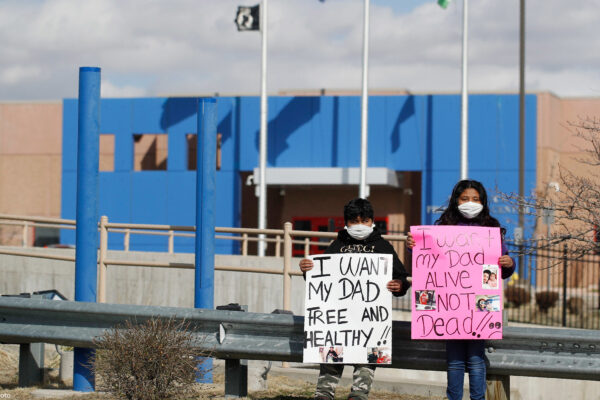The cruelty of the U.S. Immigration and Customs Enforcement (ICE) agency was on full display this past year. The agency refused to take vital measures to curb the spread of COVID-19 in its detention centers, even in the face of its own experts’ findings that the crude facilities were “tinderboxes” for the disease.
Detained immigrants — compelled by the specter of illness and death in ICE’s jails — brought ICE to court over the inhuman conditions, with representation from the ACLU and its affiliates throughout California and around the country. Their actions led to findings that ICE was imprisoning medically vulnerable seniors in cramped, over-crowded cells; withholding COVID-19 tests to avoid having to deal with positive results; and retaliating against dissent by various means, including threatening to cut off access to soap.
Judges ruled that the conditions in ICE facilities were “inconsistent with contemporary standards of human decency.” And they ordered ICE to let people go. (See our timeline.)
Before the ACLU’s lawsuits were filed, there were more than 42,000 people detained nationwide each day. At its lowest point during the pandemic, this number fell to just over 13,000 people detained nationwide each day. In California, there were more than 3,000 immigrants detained at the Adelanto, Mesa Verde, Yuba, Otay Mesa, and Imperial detention centers. Today, there are fewer than 1,000. And despite baseless outcries by government officials and the for-profit companies that operate the detention centers that drastically reducing the population of the centers would lead to havoc and widespread lawlessness, just the opposite happened.
Released immigrants, many of whom went home to their families, overwhelmingly complied with their court-ordered release conditions. Indeed, these releases offered a blueprint for a new future where instead of languishing in cruel, senseless detention, immigrants could retain their liberty and dignity while their immigration cases move forward.
Their stories are testament to the viability and urgency of a world without unjust immigrant detention. To cite three examples:
- Adrián Rodriguez Alcantara and his partner Yasmani Osorio Reyna (pictured) are Cuban asylum seekers who first arrived in the U.S. in January 2020. The couple fled Cuba — where Adrián coordinated overseas medical mission trips and Yasmani worked at a radio and television agency — in search of the right to love each other freely. They were detained in the Otay Mesa Detention Center in San Diego for three months during the beginning of the pandemic while they waited for their asylum claims to be heard. As an individual with HIV, Adrián lived in constant stress and fear that he would contract COVID-19 and not make it out of Otay Mesa alive. Adrián and Yasmani were released on April 30, 2020, after filing a class action lawsuit seeking their release and the release of others in the facility. Their courage protected not only themselves, but nearly one hundred other medically vulnerable individuals whose releases were secured through the lawsuit.
- Sithy Bin was born in a Cambodian refugee camp and arrived in the U.S. as a toddler. Following the completion of 15 years on a 40-years-to-life sentence, after which a judge determined his exemplary conduct in prison had earned him a second chance, he was transferred to ICE custody at the Mesa Verde ICE Processing Facility in Bakersfield. There, he was closely confined with other men in his unit, none of whom received COVID-19 tests during his time in Since his release he has become a program administrator at Inglewood Wrapping Arms Around the Community, a nonprofit that offers community services and re-entry programs for marginalized people. He does social media work for a church ministry and attends Pacific Oaks College where he is pursuing a bachelor’s degree in human development.
- Alejandro Jeronimo Osorio, originally from Mexico, has lived in the U.S. for nearly 30 years. He has diabetes, hypertension, and asthma, conditions that put him at heightened risk of serious illness or death from COVID-19. He was released by court order in September 2020, with the judge finding that Alejandro, who had completed extensive rehabilitation programs following misdemeanor convictions, posed neither a danger nor a flight risk, and that his continued detention during the pandemic was likely unconstitutional. Two weeks after his release, Alejandro was granted custody of his three children, including a son who has a serious heart condition that recently required surgery. Alejandro was relieved he was able to be there to care for his son, as well as provide support for all his children.
Today, the Biden administration is faced with a choice. It can follow in the footsteps of the Trump administration and refill the now-empty jail cells. Or it can acknowledge what government studies have shown for years and what the experience of the past year has proven beyond doubt — that in the vast majority of cases, detention is not only cruel, but unnecessary to ensure immigrants’ presence at civil immigration proceedings. Humane, community-based alternatives to detention are more than capable of securing their presence while preserving individual liberty and dignity, and keeping families together.
So far, however, the signs from Washington are not good. Immigration detention numbers are rising, and the Biden administration persists in defending ICE’s cruelty in court. The government has yet to commit to protect people who were released due to COVID-19 from re-detention. It is not too late, but we need to act now.
Those of us who believe in a world without unjust immigrant detention must raise our voices and call on Department of Homeland Security Secretary Mayorkas to shut down ICE facilities immediately, before their cruelty wreaks havoc on yet another generation.


